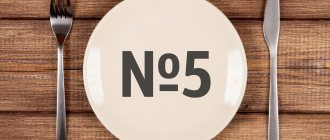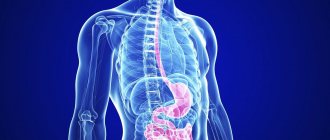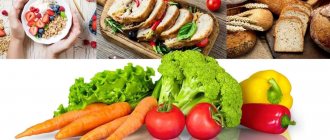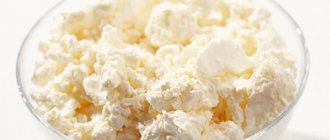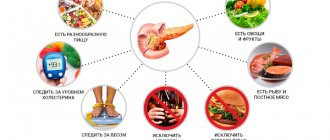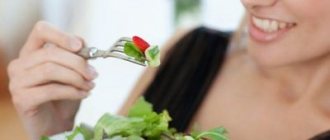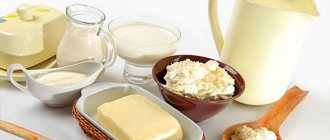11/25/2019 Article
- general characteristics
- Table "Do's and Don'ts"
- Menu for the week
- Diet modifications Diet “Table 1A”
- Diet "Table 1B"
The “1 table” diet , developed by the Soviet nutritionist M.I. Pevzner, is prescribed for the following diseases:
- peptic ulcer of the stomach and duodenum during the recovery period after a sharp exacerbation and with a mild exacerbation;
- mild exacerbation of chronic gastritis with preserved or increased secretion;
- acute gastritis during the recovery period.
The “1 table” diet is considered tough, but it is designed to support the digestive tract and help it recover.
Find a trusted dietitian in your city and make an appointment online
Consultation with a nutritionist
general characteristics
Goal of the diet:
moderate chemical, mechanical and thermal sparing of the gastrointestinal tract with adequate nutrition, reducing inflammation, improving the healing of ulcers, normalizing the secretory and motor functions of the stomach.
General characteristics:
In terms of calories, protein, fat and carbohydrate content, it is a physiologically complete diet. Strong stimulants of gastric secretion, irritants of its mucous membrane, the portion that lingers in the stomach and difficult to digest foods and dishes are limited. Food is prepared mainly pureed, boiled in water or steamed. Some dishes are baked without a crust. Fish and non-rough meats are allowed in pieces. Table salt is moderately limited. Very cold and hot dishes are excluded.
Chemical composition and calorie content:
- carbohydrates - 400-420 g;
- proteins - 90-100 g (60% animals),
- fats - 100 g (30% vegetable),
- calories - 2800-3000 kcal;
- sodium chloride (salt) 10-12 g,
- free liquid - 1.5 l.
Diet:
5-6 times a day. Before bed: milk, cream.
Medicinal products
Despite the wide range of foods and drinks allowed for consumption, for stomach ulcers, among them there are those that have a healing effect. They support the body during such a critical period and actively fight the bacterium Helicobacter Pylori, which causes ulcers and erosions on the mucous membrane of the stomach and duodenum.
These include:
- Milk. Envelops the walls of the stomach, speeds up the healing process. However, you should drink the drink carefully, as it can cause heartburn and pain.
- Honey. Relieves inflammation and irritation of the gastric mucosa, reduces secretion and neutralizes the effect of hydrochloric acid, relieves pain. In addition, honey increases hemoglobin levels and prevents the development of anemia.
- Freshly squeezed cabbage juice. The medicinal properties of the drink are due to the content of anti-ulcer vitamin U and a stable form of ascorbic acid in the composition. It is the juice that fights pathogenic bacteria Helicobacter Pylori and stimulates scarring of wounds.
- Yogurt. Biologically active bacteria (Bulgarian bacillus, probiotics, lactic acid streptococci) included in the product suppress the activity of harmful microorganisms that cause stomach ulcers. In addition, yogurt contains a bioavailable protein that has a wound-healing effect on the ulcerated surface of the mucous membrane of the damaged organ.
Interestingly, in the laboratories of Guangzhou, China, an acidophilic yogurt starter containing the Helicobacter pylori adhesin gene was invented. This component fights pathogenic flora, which causes exacerbation of stomach ulcers. Today the product is at the development stage with the goal of subsequent introduction into mass production.
Do's and don'ts
Recommended and excluded foods and dishes of the “1 table” diet:
Table “What is allowed and what is not allowed”
| Products and dishes | What is possible | What not to do |
| Soups | From permitted pureed vegetables in carrot and potato broth, milk soups from pureed or well-cooked cereals (rolled oats, semolina, rice, etc.), vermicelli with the addition of pureed vegetables, milk pureed soups from vegetables: pureed soup from pre-cooked chicken or meat, from mashed sweet berries with semolina. Flour for soups is only dried. Soups are seasoned with butter, egg-milk mixture, and cream. | Meat and fish broths, mushroom and strong vegetable broths, cabbage soup, borscht, okroshka. |
| Bread and flour products | Wheat bread made from premium and 1st grade flour, yesterday baked or dried; dry biscuit, dry biscuits, 1-2 times a week well-baked savory buns, baked pies with apples, boiled meat or fish and eggs, jam, cheesecake with cottage cheese. | Rye and any fresh bread, butter and puff pastry products. |
| Meat and poultry | Low-fat, without tendons, fascia, skin in birds. Steamed and boiled dishes from beef, young lean lamb and trimmed pork, chicken, turkey. Boiled dishes, including pieces of lean veal, chicken, and rabbit. Steamed cutlets, meatballs, quenelles, soufflés, purees, zrazy; beef stroganoff made from boiled meat. Boiled meat baked in the oven. Boiled tongue and liver. | Fatty or stringy varieties of meat and poultry, duck, goose, canned food, smoked meats. |
| Fish | Low-fat types without skin, in pieces or in the form of cutlets: boiled in water or steamed. | Fatty, salted fish, canned food. |
| Dairy | Milk, cream. Non-acidic kefir, yogurt, acidophilus. Fresh non-acidic cottage cheese (mashed) and sour cream. Curd dishes: baked cheesecakes, soufflé, lazy dumplings, puddings. Mild grated cheese, occasionally in slices. | High acidity dairy products, sharp, salty cheeses. Limit sour cream. |
| Eggs | Soft-boiled, steam omelette. | Hard-boiled and fried eggs. |
| Cereals | Semolina, rice, buckwheat, oatmeal. Porridges cooked in milk or water are semi-viscous and mashed (buckwheat). Steam souffles, puddings, cutlets from ground cereals. Vermicelli, finely chopped boiled pasta. | Millet, pearl barley, barley, corn grits, legumes, whole pasta. |
| Vegetables | Potatoes, carrots, beets, cauliflower, limited green peas. Steamed or boiled in water and pureed (mashed potatoes, soufflés, steam puddings). Unpureed early pumpkin and zucchini. Finely chopped dill - in soups. Ripe non-acidic tomatoes up to 100 g. | White cabbage, turnips, rutabaga, radishes, sorrel, spinach, onions, cucumbers, salted, pickled and pickled vegetables, mushrooms, canned vegetable snacks. |
| Snacks | Salad of boiled vegetables, meat, fish. Boiled tongue, liver pate, doctor's sausage, milk sausage, dietary sausage; jellied fish in vegetable broth, sturgeon caviar, occasionally soaked low-fat herring and mincemeat, mild cheese, unsalted ham without fat. | All spicy and salty snacks, canned food, smoked foods. |
| Fruits, sweet dishes, sweets | Mashed, boiled and baked sweet berries and fruits. Purees, jelly, mousses, jellies, sambuca, compotes (mashed). Meringues, snowballs, butter cream, milk jelly. Sugar, honey, sour jam, marshmallows, marshmallows. | Sour, insufficiently ripe, fiber-rich fruits and berries, unprocessed dried fruits, chocolate, ice cream. |
| Sauces and spices | Milk (bechamel) without sautéing flour, with the addition of butter, sour cream, fruit, milk-fruit. Limited - dill, parsley, vanillin, cinnamon. | Meat, fish, mushroom, tomato sauces, horseradish, mustard, pepper. |
| Beverages | Weak tea, tea with milk, cream, weak cocoa and coffee with milk. Sweet juices from fruits and berries. Rose hip decoction. | Carbonated drinks, kvass, black coffee. |
| Fats | Unsalted butter, premium quality cow's ghee. Refined vegetable oils added to dishes. | All other fats. |
Recipes
Diet pate
Ingredients: 100 g beef, two potatoes, medium carrots.
Boil the products, pass through a meat grinder: pour ½ cup of milk into the prepared minced meat, stirring, and simmer over low heat. Remove after 3-5 minutes, add a little salt.
Egg porridge
Ingredients: two eggs, 60 ml of milk, a little salt, two teaspoons of butter.
Dissolve eggs with milk, beat, add a little salt, add butter. Pour the resulting mass into a small bowl and place it in a pan of water. Cook, stirring constantly, until the consistency of porridge.
Pour the egg mixture into a saucepan with a small amount of warm water, cook like regular porridge until thickened. Strain the rest of the water.
Carrot soufflé with cottage cheese and honey
Ingredients: 500 g carrots, 250 g cottage cheese, 150 g milk, teaspoon sugar, egg, 50 g semolina, cube of butter.
Cut the carrots into pieces, pour in milk, boil until tender. Grate or beat in a blender, add grated cottage cheese, sugar, yolk and semolina. Mix the mixture well, and only then add the whipped egg white. Place in a bowl greased with oil and steam. If desired, serve with honey.
Curd soufflé
Ingredients: 250 g of cottage cheese (up to 9% fat), three eggs, a little sugar, 250 ml of milk, semolina flour.
Wipe the cottage cheese, add the yolk, sugar, milk, flour. Beat and add the whites, mix the mixture well. Place in a mold and steam. Serve with condensed milk.
Baked cutlets
Ingredients: 2 tablespoons of cottage cheese (fat content up to 9%), egg, 150 g of beef, butter.
Meat without tendons and fascia: boil and cool. Pass the beef and cottage cheese through a meat grinder twice. Beat the egg, leave a small part to grease the cutlets, pour the rest into the minced meat. Add oil, mix well until smooth. Form cutlets, place on a baking sheet, brush with egg. Bake in the oven until done.
Menu for the week: what you can eat
An example of a menu for every day according to the “1 table” diet:
Option #1
- 1st breakfast: soft-boiled egg, rice porridge with milk, tea with milk.
- 2nd breakfast: fresh non-sour cottage cheese, rosehip decoction.
- Lunch: oat milk soup, steamed meat balls with carrot puree, fruit mousse.
- Afternoon snack: rose hip decoction, crackers.
- Dinner: boiled fish, baked in milk sauce, mashed potatoes, tea with milk.
- At night: milk.
Option No. 2
- 1st breakfast: steam omelette, crumbly buckwheat porridge, tea with milk.
- 2nd breakfast: baked apple with sugar.
- Lunch: rice milk soup, steamed meat soufflé with mashed potatoes, apple jelly.
- Afternoon snack: decoction of wheat bran with sugar and crackers.
- Dinner: steamed curd soufflé, fruit jelly.
- At night: cream.
Option #3
- 1st breakfast: soft-boiled egg, semolina milk porridge, jelly.
- 2nd breakfast: curd pudding.
- Lunch: vegetarian potato soup, boiled meat, baked with bechamel sauce, boiled carrots, boiled dried fruit compote.
- Afternoon snack: rose hip decoction, savory bun.
- Dinner: boiled fish, baked with milk sauce, carrot-apple roll, tea with milk.
- At night: milk.
Option No. 4
- 1st breakfast: lazy dumplings with sour cream, oatmeal porridge, compote.
- 2nd breakfast: fresh non-sour cottage cheese, rosehip decoction.
- Lunch: milk soup with noodles, turkey quenelles with a side dish of boiled cauliflower, weak tea with milk.
- Afternoon snack: decoction of wheat bran with dry biscuit.
- Dinner: salad of boiled vegetables and boiled sausage, berry mousse, jelly.
- At night: cream.
Option #5
- 1st breakfast: soft-boiled egg, rice milk porridge.
- 2nd breakfast: baked pear with sugar, dried fruit compote.
- Lunch: pureed vegetable soup, boiled pike perch, vermicelli, weak tea.
- Afternoon snack: berry mousse.
- Dinner: meat soufflé, cottage cheese casserole, jelly.
- At night: milk.
Option #6
- 1st breakfast: steam omelette, semolina milk porridge, dried fruit compote.
- 2nd breakfast: fresh non-sour cottage cheese, rosehip decoction.
- Lunch: oat milk soup, boiled rabbit, mashed potatoes, weak tea with milk.
- Afternoon snack: decoction of wheat bran with dry biscuit.
- Dinner: boiled fish, baked with milk sauce, carrot-apple roll, jelly.
- At night: cream.
Option No. 7
- 1st breakfast: steam omelette, vermicelli with grated cheese, weak tea, meringue.
- 2nd breakfast: berry jelly, compote.
- Lunch: pureed vegetable soup, boiled carp with bechamel sauce, boiled rice, jelly.
- Afternoon snack: cottage cheese casserole, weak tea.
- Dinner: vegetable salad, turkey meatballs with a side dish of cauliflower.
- At night: milk.
Dietary and medical nutrition: large selection, low prices, promotions and discounts. Delivery as soon as possible in your city.
Diet food
Diet modifications
The “1 table” diet has two modifications: 1A and 1B.
Diet "Table 1A"
“Table 1A” is indicated for exacerbations of peptic ulcer disease, exacerbations of chronic gastritis with high acidity. The task of table No. 1a is to provide the body with all the necessary nutrients during an exacerbation and to provide favorable conditions for reducing inflammation.
All foods on the Table 1A diet must be boiled, steamed, baked without crust, and then chopped. Chopped, pureed, slimy food is the main condition and difference of this modification of the table. During an exacerbation, porridges should be crushed or slimy, poultry and fish should also be chopped and cooked in the form of soufflés or steamed cutlets. Vegetables and fruits are also thermally processed and crushed.
The list of allowed foods on table No. 1 is suitable for the diet, with the exception of all flour products, fermented milk products and confectionery. The nutritional value of this table is lower and is reduced by carbohydrate foods, since the patient is on bed rest.
The duration of the diet is on average 10 days. After this, “Table 1B” is prescribed for 14 days.
Is it possible to drink kefir at night if you have an ulcer?
Doctors advise taking kefir at night only during remission.
Lactose in the drink soothes, and beneficial bacteria normalize digestive function. If taken before bed does not cause discomfort from the gastrointestinal tract, the product can be included in the menu. Kefir promotes the healing of damaged mucous membranes when used together with unrefined vegetable oil (1 tsp per 250 ml of fermented milk drink).
Before using this mixture, you should consult a gastroenterologist.


